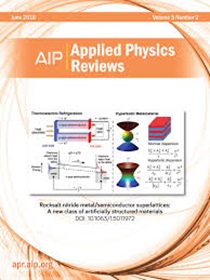Room temperature single-photon terahertz detection with thermal Rydberg atoms
IF 11.6
1区 物理与天体物理
Q1 PHYSICS, APPLIED
引用次数: 0
Abstract
Single-photon terahertz (THz) detection is one of the most demanding technologies for a variety of fields and could lead to many breakthroughs. Although significant progress has been made in the past two decades, operating it at room temperature still remains a great challenge. Here, we demonstrate, for the first time, a room temperature THz detector at single-photon levels based on nonlinear wave mixing in thermal Rydberg atomic vapor. The low-energy THz photons are coherently upconverted to high-energy optical photons via a nondegenerate Rydberg state involved in a six-wave mixing process, and therefore, single-photon THz detection is achieved by a conventional optical single-photon counting module. The noise equivalent power of such a detector reaches 9.5 × 10−19 W/Hz1/2, which is more than four orders of magnitude lower than the state-of-the-art room temperature THz detectors. The optimum quantum efficiency of the whole-wave mixing process is about 4.3%, with 40.6 dB dynamic range, and the maximum conversion bandwidth is 172 MHz, which is all-optically controllable. The developed fast and continuous-wave single-photon THz detector at room temperature operation has a great potential for portability and chip-scale integration, and could be revolutionary for a wide range of applications in remote sensing, wireless communication, biomedical diagnostics, and quantum optics.利用热里德伯原子进行室温单光子太赫兹探测
单光子太赫兹(THz)探测是各领域要求最高的技术之一,可带来许多突破。尽管在过去二十年中取得了重大进展,但在室温下运行仍是一项巨大挑战。在这里,我们首次展示了基于热雷德堡原子蒸汽中非线性波混合的单光子级室温太赫兹探测器。低能太赫兹光子通过参与六波混合过程的非退化雷德贝格态相干上转换为高能光学光子,因此,单光子太赫兹检测是通过传统的光学单光子计数模块实现的。这种探测器的噪声等效功率达到 9.5 × 10-19 W/Hz1/2,比最先进的室温太赫兹探测器低四个数量级以上。全波混合过程的最佳量子效率约为 4.3%,动态范围为 40.6 dB,最大转换带宽为 172 MHz,全光可控。所开发的室温下快速连续波单光子太赫兹探测器在便携性和芯片级集成方面具有巨大潜力,可在遥感、无线通信、生物医学诊断和量子光学等领域的广泛应用中发挥革命性作用。
本文章由计算机程序翻译,如有差异,请以英文原文为准。
求助全文
约1分钟内获得全文
求助全文
来源期刊

Applied physics reviews
PHYSICS, APPLIED-
CiteScore
22.50
自引率
2.00%
发文量
113
审稿时长
2 months
期刊介绍:
Applied Physics Reviews (APR) is a journal featuring articles on critical topics in experimental or theoretical research in applied physics and applications of physics to other scientific and engineering branches. The publication includes two main types of articles:
Original Research: These articles report on high-quality, novel research studies that are of significant interest to the applied physics community.
Reviews: Review articles in APR can either be authoritative and comprehensive assessments of established areas of applied physics or short, timely reviews of recent advances in established fields or emerging areas of applied physics.
 求助内容:
求助内容: 应助结果提醒方式:
应助结果提醒方式:


